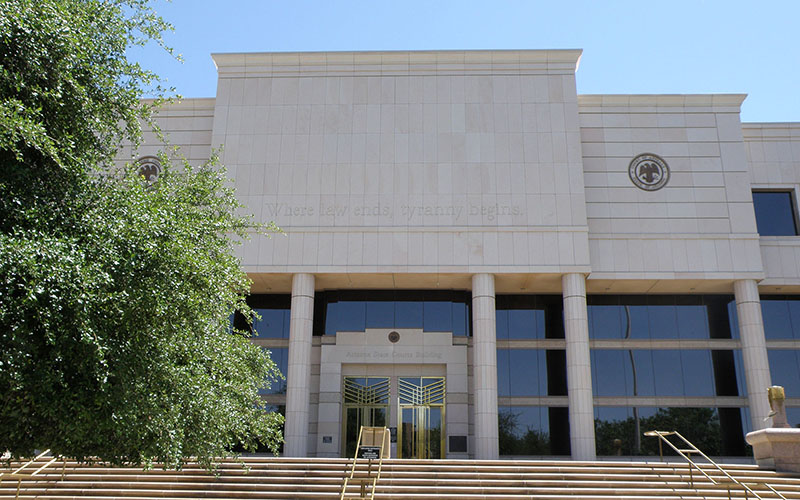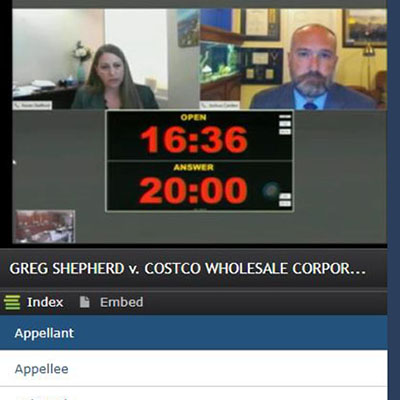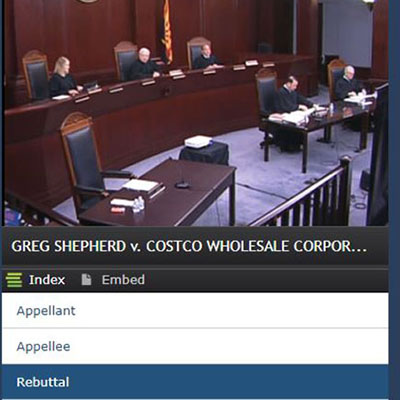
The facade of the Arizona State Courts Building where the Supreme Court this week began hearing arguments via videoconference from attorneys who were off-site, as the justices worked to continue processing cases while practicing social distancing in the face of the coronavirus. The courtroom itself was reconfigured so justices could maintain the proper distance. (Photo by Kevin Bondelli/Creative Commons)
TEMPE – Joshua Carden had reason to be nervous as he argued his first case before the Arizona Supreme Court this week – never mind that he also had to argue that case over video from an office in his basement.
Carden was one of the first attorneys to argue before the justices via video conference, as the court tried to continue its work while practicing social distancing in the face of COVID-19.
The court has long live-streamed its proceedings to viewers outside the courtroom, but Tuesday was the first time the justices heard arguments streamed in to them. Three cases were argued Tuesday and three more were scheduled for videoconference arguments Thursday.
The state Supreme Court is not the first to hear video arguments, something that has been done “for years” in the 9th U.S. Circuit Court of Appeals and that was adopted recently by Maricopa County Superior Court to cope with the coronavirus.
One Maricopa County judge and one law professor said the set-up is not ideal, as it makes it hard for judges and attorneys to pick up on nonverbal cues during arguments. Carden said that while it took a little getting used to, he was glad to have the opportunity.
Carden has been working from home for some time now and said “the only new part was wearing a suit” in his office basement for the arguments.

Attorneys Karen Stafford and Joshua Carden argue – from different locations – before the Arizona Supreme Court, which started hearing arguments this week via videoconference to allow for hearings while social distancing. (Photo courtesy Arizona Supreme Court)
“I had to go ahead and wear the full suit because I wasn’t sure whether they were going to announce, ‘All rise’ the way they normally do when court starts,” he said. “I was like, this will be the day where I am wearing red gym shorts and they say all rise and I’ve got to stand up.”
Many courts have traditionally resisted the introduction of electronics into hearings: The U.S. Supreme Court made news this week when it announced that it would hear arguments in 10 cases next month by conference call. But for other courts, hearing arguments remotely is not new.
Susan Gelmis, chief deputy clerk for the 9th U.S. Circuit Court of Appeals, said judges in the sprawling 13-state circuit have been hearing oral arguments via video for many years now, depending on the situation.
“We have one judge who because of his health is not able to travel, so when he sits outside of his hometown of Seattle, he always appears by video,” Gelmis said. “He’s been doing that for years.”
Gelmis said other times when the court might take video arguments include when a lawyer is out of the country or unable to travel to the court.
“We have done remote participation by judges or lawyers for a very long time,” Gelmis said. “What’s new is that right now, nobody needs permission. In fact, our courthouses are closed to the public, so all of it is remote.”
Arizona Supreme Court justices were in the courtroom for this week’s arguments – but seated a distance from each other to prevent the spread of the coronavirus – but Gelmis said the only people in the circuit’s courtrooms these days are the technician running the setup and the court deputy.
In Maricopa County Superior Court, most hearings have been held through some form of videoconferencing since COVID-19, Judge Chris Whitten said.

Arizona Supreme Court justices sit at coronavirus-safe distances while listening to arguments from attorneys via videoconference in Shepherd v. Costco, the first case the court heard in which attorneys were at remote locations. (Photo courtesy the Arizona Supreme Court)
“The judges are being really innovative and lawyers are being super flexible and patient,” Whitten said. He said some judges are streaming from home, while others are in the courtroom, depending on the technology available.
Whitten said while everyone has been cooperative, the transition has not been without challenges. The court’s first attempt, for example, used a bridge line that allowed up to 30 people on the call, but without any visuals, which made communication difficult and “makes it impossible to judge someone’s credibility.”
“It was just a cacophony because you had everybody on an open line and it was chaos,” Whitten said. That prompted the court’s move to a video platform.
“We do so much nonverbal communication that I am now more aware of than ever,” he said. But some people still lack access to some technology, and the court is still working on providing access to everyone.
Paul Bender, a law professor at Arizona State University’s Sandra Day O’Connor College of Law, agreed there is a lot of body language in court arguments that might not get through in a teleconference.
“I think it would be better if you could see the judge face to face when you’re arguing and having him sitting or her sitting there,” Bender said. “I think the judges would also have a better feeling about the argument and maybe get more information by being able to see the whole lawyer there, rather than the face disembodied from everything else.”
-Cronkite News video by Gabriella Khalaj
But while it might be more effective for lawyers to argue in person, Bender said he does not expect the Arizona Supreme Court going remote will pose many problems. And hearing arguments remotely is better than doing nothing, he said.
That was Carden’s reaction. He said everyone from the chief justice to the court staff was “incredibly gracious and understanding about the difficulties that such an argument would pose.”
Because this was his first time before the justices, he does not think he lost much in video arguments.
“I’ve never appeared before any of those justices in real life to know their body language well enough to be able to read it on screen,” said Carden, who only felt “a slight diminished sense of connection.”
Carden also said while the process was a bit awkward, he is grateful that the court isn’t putting cases on hold until the shutdown is over.
“They’re actually hearing cases and making decisions and making it work,” he said. “In this season, seeing justice still get done I think it is important for the rest of us to feel comfortable with where we’re headed as a country.”
-Cronkite News reporter Gabriella Khalaj contributed to this report from Washington.


